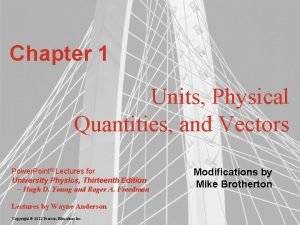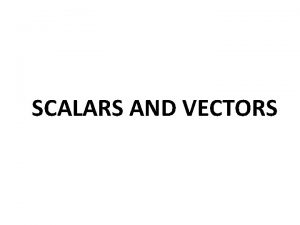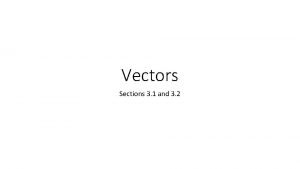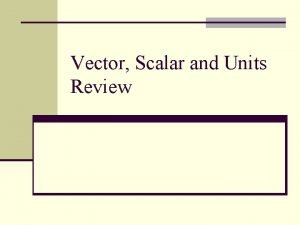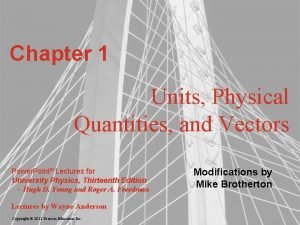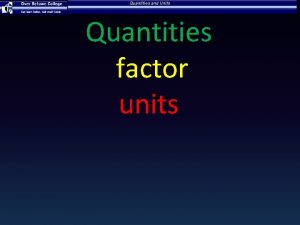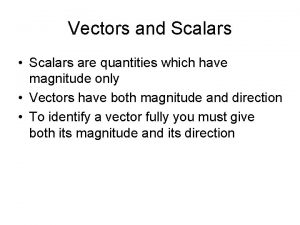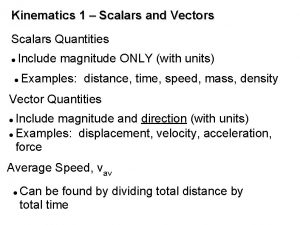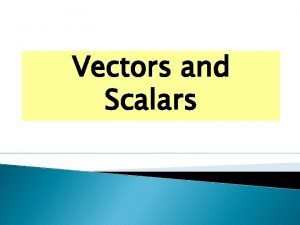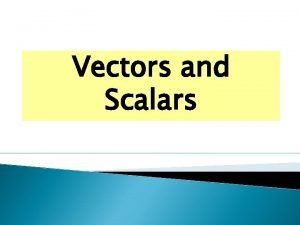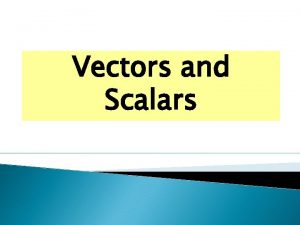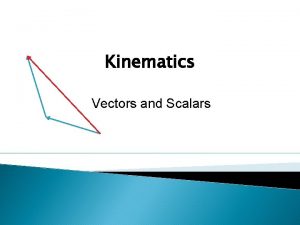Units scalars and vectors Physical quantities Any quantity










- Slides: 10

Units, scalars and vectors

Physical quantities • Any quantity that can be quantified by measurement is a physical quantity • Most of the quantities we deal with as scientists are physical quantities and they will be the ones we will discuss throughout this topic of motion. • Can you name some physical quantities and non-physical quantities

Fundamental units are defined arbitrarily and not by combinations with other units. There are 7 fundamental units. Quantity Distance Mass Time Current Temperature Luminosity intensity Amount of a substance Base unit

Derived units are units which may be expressed in terms of fundamental units by means of mathematical of multiplication and division Quantity Speed Acceleration Area volume Force Energy Hertz Derived unit

Standard units • The Units I have used to fill in the previous tables are called standard units. These are always used to describe quantities when in a scientific setting. • Quantities can be described using a variety of units. For example distance can be in meters (m) kilometres (km), centimetres (cm) etc. but…. . • Scientists always use the same units when expressing quantities • This allows scientists to communicate effectively and efficiently • The mathematical formulae which relate different quantities, for example velocity, acceleration and concentration, are all developed using standard units and will give incorrect relationships if standard units are not used

Significant Figures Significant figures are an expression of how precise a measurement is. For example a measurement reported as 254. 00 is more precise than 254 as it implies a knowledge of the measurement to the hundredths compared to the “ones” In laboratory science the significant figures we use are based on an instruments precision. You have seen than the callipers have more precision than a millimetre ruler and therefore a measurement from these will have more significant figures Eg vernier calliper measurement 11. 24 mm compared to 11. 2 mm from ruler

Significant Figures rules for the classroom • When doing a laboratory use the instrument to guide your significant figures. • Significant figures from an instrument will be all the figures you can derive with certainty from the instrument plus one estimated figure. • When doing calculations always use 3 significant figures unless the question specifically states the number of SF.

Significant figure rules • All non-zero digits are significant. Eg 3260 • Zeros between non-zero digits are significant. Eg 307 • Leading zeros are never significant. Eg 00052. 3 • In a number with a decimal point, trailing zeros, those to the right of the first non-zero digit, are significant. E. g. 0. 004600 • In a number without a decimal point, trailing zeros may or may not be significant. More information through additional graphical symbols or explicit information on errors is needed to clarify the significance of trailing zeros. E. g. 5, 400, 000?

Vector and scalar quantities A scalar quantity it a quantity that has only magnitude A vector quantity is a quantity that has both magnitude and direction.

Decide if these are scalar or vector quantities • • • Velocity Distance Displacement Force Energy • • • Mass Weight Area Time Volume
 Physical quantities of vectors
Physical quantities of vectors Scalar quantity unit
Scalar quantity unit Vectors and scalars in physics
Vectors and scalars in physics Components of vectors
Components of vectors Scalar quantity vs vector
Scalar quantity vs vector Entropy is scalar or vector
Entropy is scalar or vector Vectors form 3
Vectors form 3 Multiplying or dividing vectors by scalars results in
Multiplying or dividing vectors by scalars results in Magnetic field intensity is scalar or vector
Magnetic field intensity is scalar or vector Antiparallel vectors
Antiparallel vectors Angular and linear quantities
Angular and linear quantities
